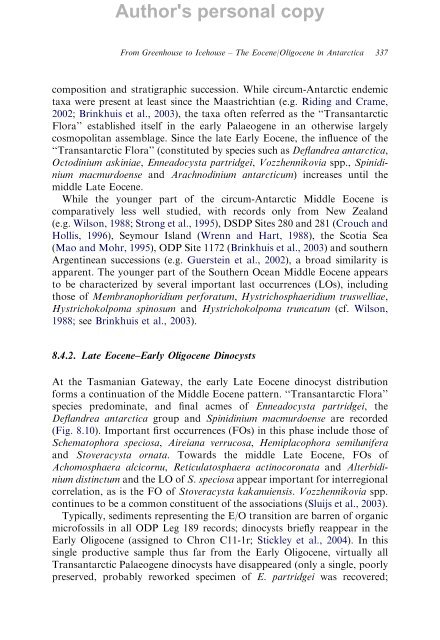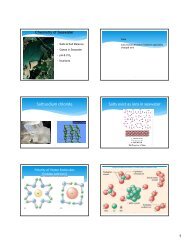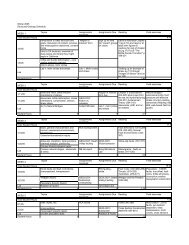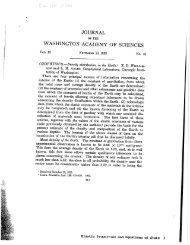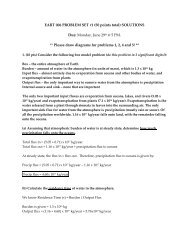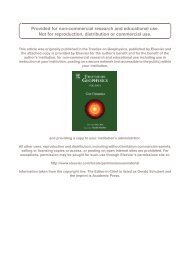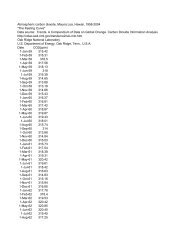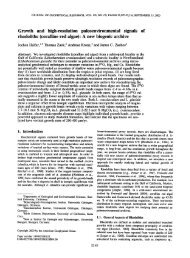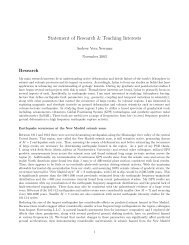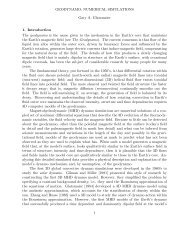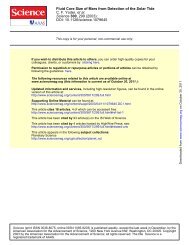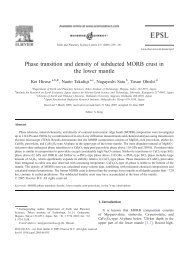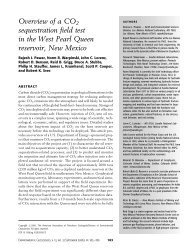From Greenhouse to Icehouse – The Eocene/Oligocene - UMass ...
From Greenhouse to Icehouse – The Eocene/Oligocene - UMass ...
From Greenhouse to Icehouse – The Eocene/Oligocene - UMass ...
Create successful ePaper yourself
Turn your PDF publications into a flip-book with our unique Google optimized e-Paper software.
Author's personal copy<br />
<strong>From</strong> <strong>Greenhouse</strong> <strong>to</strong> <strong>Icehouse</strong> <strong>–</strong> <strong>The</strong> <strong>Eocene</strong>/<strong>Oligocene</strong> in Antarctica 337<br />
composition and stratigraphic succession. While circum-Antarctic endemic<br />
taxa were present at least since the Maastrichtian (e.g. Riding and Crame,<br />
2002; Brinkhuis et al., 2003), the taxa often referred as the ‘‘Transantarctic<br />
Flora’’ established itself in the early Palaeogene in an otherwise largely<br />
cosmopolitan assemblage. Since the late Early <strong>Eocene</strong>, the influence of the<br />
‘‘Transantarctic Flora’’ (constituted by species such as Deflandrea antarctica,<br />
Oc<strong>to</strong>dinium askiniae, Enneadocysta partridgei, Vozzhennikovia spp., Spinidinium<br />
macmurdoense and Arachnodinium antarcticum) increases until the<br />
middle Late <strong>Eocene</strong>.<br />
While the younger part of the circum-Antarctic Middle <strong>Eocene</strong> is<br />
comparatively less well studied, with records only from New Zealand<br />
(e.g. Wilson, 1988; Strong et al., 1995), DSDP Sites 280 and 281 (Crouch and<br />
Hollis, 1996), Seymour Island (Wrenn and Hart, 1988), the Scotia Sea<br />
(Mao and Mohr, 1995), ODP Site 1172 (Brinkhuis et al., 2003) and southern<br />
Argentinean successions (e.g. Guerstein et al., 2002), a broad similarity is<br />
apparent. <strong>The</strong> younger part of the Southern Ocean Middle <strong>Eocene</strong> appears<br />
<strong>to</strong> be characterized by several important last occurrences (LOs), including<br />
those of Membranophoridium perforatum, Hystrichosphaeridium truswelliae,<br />
Hystrichokolpoma spinosum and Hystrichokolpoma truncatum (cf. Wilson,<br />
1988; see Brinkhuis et al., 2003).<br />
8.4.2. Late <strong>Eocene</strong><strong>–</strong>Early <strong>Oligocene</strong> Dinocysts<br />
At the Tasmanian Gateway, the early Late <strong>Eocene</strong> dinocyst distribution<br />
forms a continuation of the Middle <strong>Eocene</strong> pattern. ‘‘Transantarctic Flora’’<br />
species predominate, and final acmes of Enneadocysta partridgei, the<br />
Deflandrea antarctica group and Spinidinium macmurdoense are recorded<br />
(Fig. 8.10). Important first occurrences (FOs) in this phase include those of<br />
Schema<strong>to</strong>phora speciosa, Aireiana verrucosa, Hemiplacophora semilunifera<br />
and S<strong>to</strong>veracysta ornata. Towards the middle Late <strong>Eocene</strong>, FOs of<br />
Achomosphaera alcicornu, Reticula<strong>to</strong>sphaera actinocoronata and Alterbidinium<br />
distinctum and the LO of S. speciosa appear important for interregional<br />
correlation, as is the FO of S<strong>to</strong>veracysta kakanuiensis. Vozzhennikovia spp.<br />
continues <strong>to</strong> be a common constituent of the associations (Sluijs et al., 2003).<br />
Typically, sediments representing the E/O transition are barren of organic<br />
microfossils in all ODP Leg 189 records; dinocysts briefly reappear in the<br />
Early <strong>Oligocene</strong> (assigned <strong>to</strong> Chron C11-1r; Stickley et al., 2004). In this<br />
single productive sample thus far from the Early <strong>Oligocene</strong>, virtually all<br />
Transantarctic Palaeogene dinocysts have disappeared (only a single, poorly<br />
preserved, probably reworked specimen of E. partridgei was recovered;


